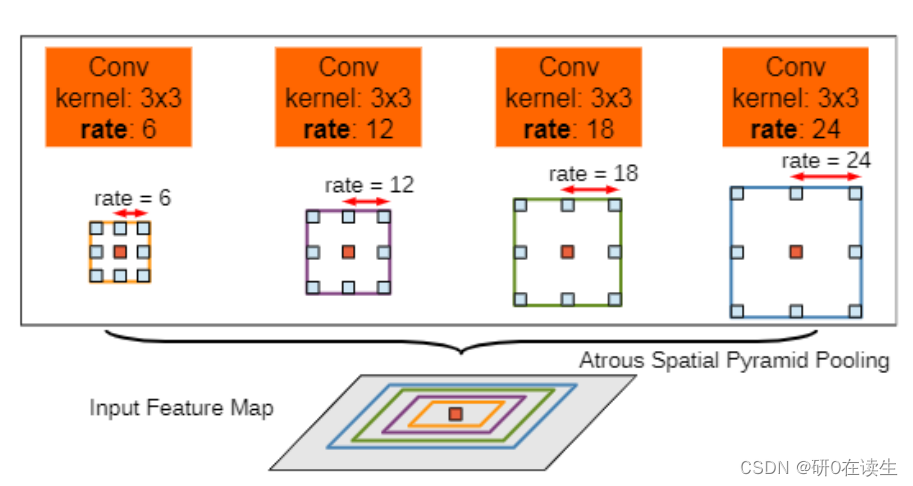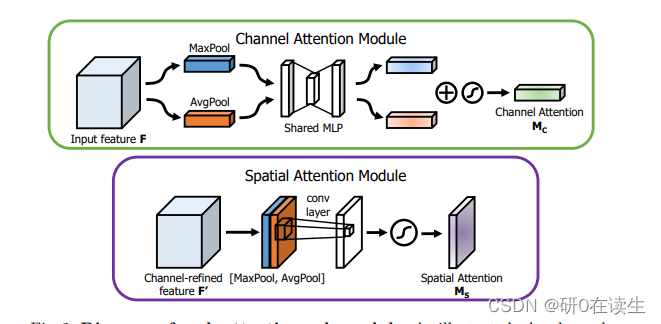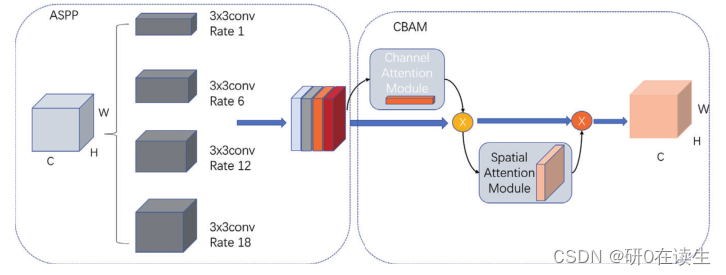改进版ASPP(2):ASPP模块中加入CBAM(卷积注意力模块),即CBAM_ASPP
1、ASPP模型结构

空洞空间卷积池化金字塔(atrous spatial pyramid pooling (ASPP))通过对于输入的特征以不同的采样率进行采样,即从不同尺度提取输入特征,然后将所获取的特征进行融合,得到最终的特征提取结果。
2、CBAM结构


CBAM包含CAM(Channel Attention Module)和SAM(Spartial Attention Module)两个子模块,分别在通道上和空间上添加注意力机制。这样不仅可以节约参数和计算力,而且保证了其能够做为即插即用的模块集成到现有的网络架构中去。
CBAM代码如下:
import torchimport torch.nn as nnclass CBAMLayer(nn.Module): def __init__(self, channel, reduction=16, spatial_kernel=7): super(CBAMLayer, self).__init__() # channel attention 压缩H,W为1 self.max_pool = nn.AdaptiveMaxPool2d(1) self.avg_pool = nn.AdaptiveAvgPool2d(1) # shared MLP self.mlp = nn.Sequential( # Conv2d比Linear方便操作 # nn.Linear(channel, channel // reduction, bias=False) nn.Conv2d(channel, channel // reduction, 1, bias=False), # inplace=True直接替换,节省内存 nn.ReLU(inplace=True), # nn.Linear(channel // reduction, channel,bias=False) nn.Conv2d(channel // reduction, channel, 1, bias=False) ) # spatial attention self.conv = nn.Conv2d(2, 1, kernel_size=spatial_kernel, padding=spatial_kernel // 2, bias=False) self.sigmoid = nn.Sigmoid() def forward(self, x): max_out = self.mlp(self.max_pool(x)) avg_out = self.mlp(self.avg_pool(x)) channel_out = self.sigmoid(max_out + avg_out) x = channel_out * x max_out, _ = torch.max(x, dim=1, keepdim=True) # print('max_out:',max_out.shape) avg_out = torch.mean(x, dim=1, keepdim=True) # print('avg_out:',avg_out.shape) a=torch.cat([max_out, avg_out], dim=1) # print('a:',a.shape) spatial_out = self.sigmoid(self.conv(torch.cat([max_out, avg_out], dim=1))) # print('spatial:',spatial_out.shape) x = spatial_out * x # print('x:',x.shape) return x(如果要直接使用下面的CBAM_ASPP改进代码,建议将这块代码新建py文件保存,然后在CBAM_ASPP所在python文件中导入CBAMLayer类)
3、改进ASPP:CBAM_ASPP结构

该改进方式与之前的SE_ASPP改进方式相同(感兴趣的可以点击了解SE_ASPP),也是把CBAM产生的权重值与原本输入的各个特征进行相乘,作为输入特征,可以直接使用。代码如下
class (nn.Module): ##加入通道注意力机制 def __init__(self, dim_in, dim_out, rate=1, bn_mom=0.1): super(CBAM_ASPP, self).__init__() self.branch1 = nn.Sequential( nn.Conv2d(dim_in, dim_out, 1, 1, padding=0, dilation=rate, bias=True), nn.BatchNorm2d(dim_out, momentum=bn_mom), nn.ReLU(inplace=True), ) self.branch2 = nn.Sequential( nn.Conv2d(dim_in, dim_out, 3, 1, padding=6 * rate, dilation=6 * rate, bias=True), nn.BatchNorm2d(dim_out, momentum=bn_mom), nn.ReLU(inplace=True), ) self.branch3 = nn.Sequential( nn.Conv2d(dim_in, dim_out, 3, 1, padding=12 * rate, dilation=12 * rate, bias=True), nn.BatchNorm2d(dim_out, momentum=bn_mom), nn.ReLU(inplace=True), ) self.branch4 = nn.Sequential( nn.Conv2d(dim_in, dim_out, 3, 1, padding=18 * rate, dilation=18 * rate, bias=True), nn.BatchNorm2d(dim_out, momentum=bn_mom), nn.ReLU(inplace=True), ) self.branch5_conv = nn.Conv2d(dim_in, dim_out, 1, 1, 0, bias=True) self.branch5_bn = nn.BatchNorm2d(dim_out, momentum=bn_mom) self.branch5_relu = nn.ReLU(inplace=True) self.conv_cat = nn.Sequential( nn.Conv2d(dim_out * 5, dim_out, 1, 1, padding=0, bias=True), nn.BatchNorm2d(dim_out, momentum=bn_mom), nn.ReLU(inplace=True), ) # print('dim_in:',dim_in) # print('dim_out:',dim_out) self.cbam=CBAMLayer(channel=dim_out*5) def forward(self, x): [b, c, row, col] = x.size() conv1x1 = self.branch1(x) conv3x3_1 = self.branch2(x) conv3x3_2 = self.branch3(x) conv3x3_3 = self.branch4(x) global_feature = torch.mean(x, 2, True) global_feature = torch.mean(global_feature, 3, True) global_feature = self.branch5_conv(global_feature) global_feature = self.branch5_bn(global_feature) global_feature = self.branch5_relu(global_feature) global_feature = F.interpolate(global_feature, (row, col), None, 'bilinear', True) feature_cat = torch.cat([conv1x1, conv3x3_1, conv3x3_2, conv3x3_3, global_feature], dim=1) # print('feature:',feature_cat.shape) # 加入cbam注意力机制 cbamaspp=self.cbam(feature_cat) result1=self.conv_cat(cbamaspp) return resultReference
[1].Z. Zhu et al., “Semantic Segmentation of FOD Using an Improved Deeplab V3+ Model,” 2022 12th International Conference on CYBER Technology in Automation, Control, and Intelligent Systems (CYBER), 2022, pp. 791-796, doi: 10.1109/CYBER55403.2022.9907730.
[2].Woo, S., Park, J., Lee, JY., Kweon, I.S. (2018). CBAM: Convolutional Block Attention Module. In: Ferrari, V., Hebert, M., Sminchisescu, C., Weiss, Y. (eds) Computer Vision – ECCV 2018. ECCV 2018. Lecture Notes in Computer Science(), vol 11211. Springer, Cham.
来源地址:https://blog.csdn.net/qq_45014374/article/details/127782301
免责声明:
① 本站未注明“稿件来源”的信息均来自网络整理。其文字、图片和音视频稿件的所属权归原作者所有。本站收集整理出于非商业性的教育和科研之目的,并不意味着本站赞同其观点或证实其内容的真实性。仅作为临时的测试数据,供内部测试之用。本站并未授权任何人以任何方式主动获取本站任何信息。
② 本站未注明“稿件来源”的临时测试数据将在测试完成后最终做删除处理。有问题或投稿请发送至: 邮箱/279061341@qq.com QQ/279061341














